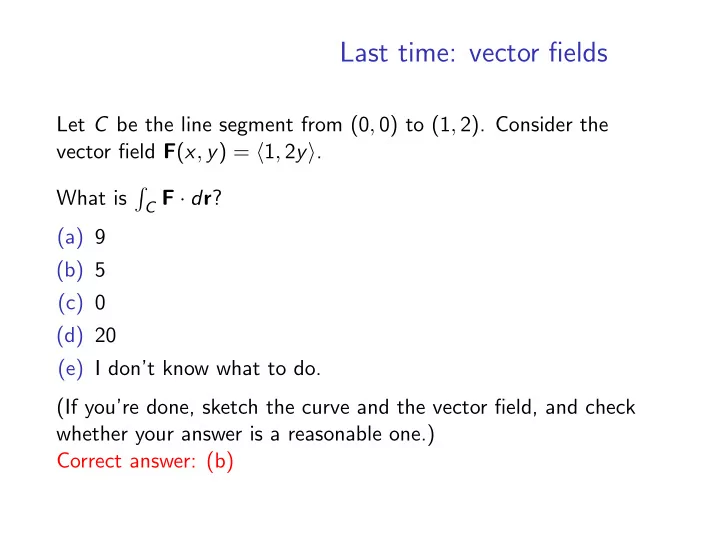

Last time: vector fields Let C be the line segment from (0 , 0) to (1 , 2). Consider the vector field F ( x , y ) = ⟨ 1 , 2 y ⟩ . ∫︁ What is C F · d r ? (a) 9 (b) 5 (c) 0 (d) 20 (e) I don’t know what to do. (If you’re done, sketch the curve and the vector field, and check whether your answer is a reasonable one.) Correct answer: (b)
Solution: Let C be parametrized by r ( t ) = ⟨ t , 2 t ⟩ , t ∈ [0 , 1]. We have F ( x , y ) = ⟨ 1 , 2 y ⟩ . ∙ F ( r ( t )) = ⟨ 1 , 4 t ⟩ . ∙ r ′ ( t ) = ⟨ 1 , 2 ⟩ . ∫︂ 1 ∫︂ ⇒ F · d r = ⟨ 1 , 4 t ⟩ · ⟨ 1 , 2 ⟩ dt C 0 ∫︂ 1 = 1 + 8 t dt 0 = [ t + 4 t 2 ] 1 0 = 5 .
Computing the integral of a vector field using the unit tangent vector Consider the circle C = { x 2 + y 2 = 1 } oriented clockwise. Use the formula ∫︂ ∫︂ F · d r = F · T ds C C ∫︁ to find C ⟨ y , − x ⟩ · d r , without choosing a specific parametrization of C . (a) π (b) − π (c) 2 π Correct answer (d) − 2 π (e) I don’t know how. If you’re done, choose a parametrization and check your answer by computing the integral using the original definition.
Solution Note that at a point P = ( x , y ) of the circle, F ( P ) is a unit vector (check the definiton) and T ( P ) is also a unit vector (by construction). Also, both are tangent to the circle and point clockwise. So F ( P ) = T ( P ) and F ( P ) · T ( P ) = | F ( P ) | 2 = 1. ∫︂ ∫︂ F · d r = F · T ds C C ∫︂ = ds C = L = 2 π.
Practice with the fundamental theorem of line integrals Let C be a circle in R 2 with centre P and radius r . Let f ( x , y ) = 3 x 2 + sin ( x + y ), and let F = ∇ f . ∫︁ What is C F · d r ? (a) Not enough information: I can’t do it unless you tell me the starting and ending points of the path. (b) Not enough information: I can’t do it because you haven’t told me the orientation of the circle. (c) I think I can do it, but I need more time to compute this integral. (d) It’s zero. Correct answer: (d)
Is the vector field conservative? We’re going to look at the vector field describing wind velocity. Discuss with your neighbour: is this vector field conservative? https://earth.nullschool.net/ (Remember the options below:) (a) Yes, we think it is. (b) No, we think it’s not. (c) We don’t agree/we don’t know. Answer: the vector field is not conservative. You can find circles around which the integral is not zero.
Recommend
More recommend